The Mobile Commerce Revolution is in Full Swing

The ecommerce industry is booming. A big reason why is because of the connectivity and accessibility of mobile devices and high-speed internet. As eMarketer reports, global ecommerce sales are expected to top $5 trillion by 2021, with mobile forecasted to generate at least half of all internet sales.
What’s the year ahead look like? Read on to get our complete rundown of mobile commerce statistics for 2020.
What the Numbers Say
Mobile is the new preferred personal computing device. Smartphones, tablets and laptops have helped propel the ecommerce industry to new heights. But just how far has it come in the past few years?
Back in 2017, we reported that 55% of all internet traffic came from mobile devices. Fast forward to 2018, and we were reporting that at least 35% of ecommerce sales came from a mobile device. Now we’re predicting that about 60% of internet traffic will come from mobile devices which will also generate at least 47% of all internet sales by 2021.
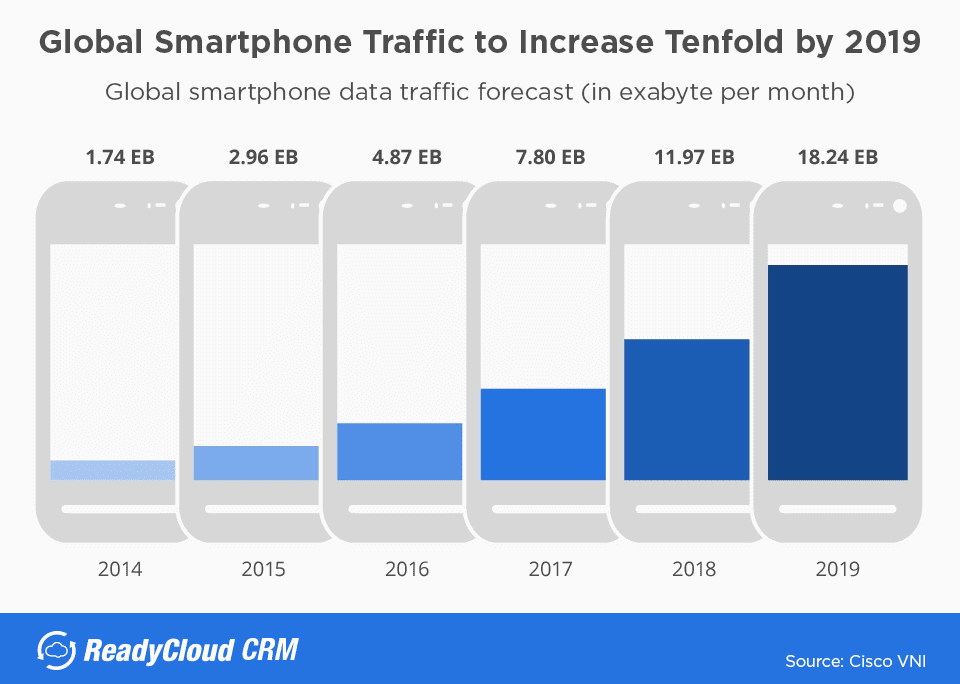
As you can see from the chart above, mobile traffic has increased ten-fold between 2014 and 2019, with predictions for 2020 showing significant gains year-over-year as mobile devices become the mainstay for internet access worldwide.
Such tremendous gains have leapfrogged mobile to become the leader in generating ecommerce purchases. Case in point: Back in 2017, mobile sales accounted for just 34.5%. This year mobile commerce will generate nearly 50% of all ecommerce sales. By 2021, it will overtake desktop and generate 53% of all purchases.

The Rise of Mobile Commerce
When did mobile commerce really become a contender? Given that early mobile devices weren’t very internet-friendly up until the early 2000s, it’s no surprise that Forrester reports that mobile commerce first went mainstream in 2006. Between 2006 and the present day, mobile commerce sales have increased steadily each year, with some dips that occurred during the Great Recession.
Putting this type of rapid growth into better perspective is an in-depth report by Oberlo, which finds that:
“Mobile commerce sales are projected to reach $2.91 trillion in 2020 – 25.4 percent more than the $2.32 trillion it registered in 2019. Mobile commerce growth has seen an average year-on-year increase of 33.8 percent since 2016. Already, revenue from mobile commerce sales in 2019 is more than two times that of 2016.”
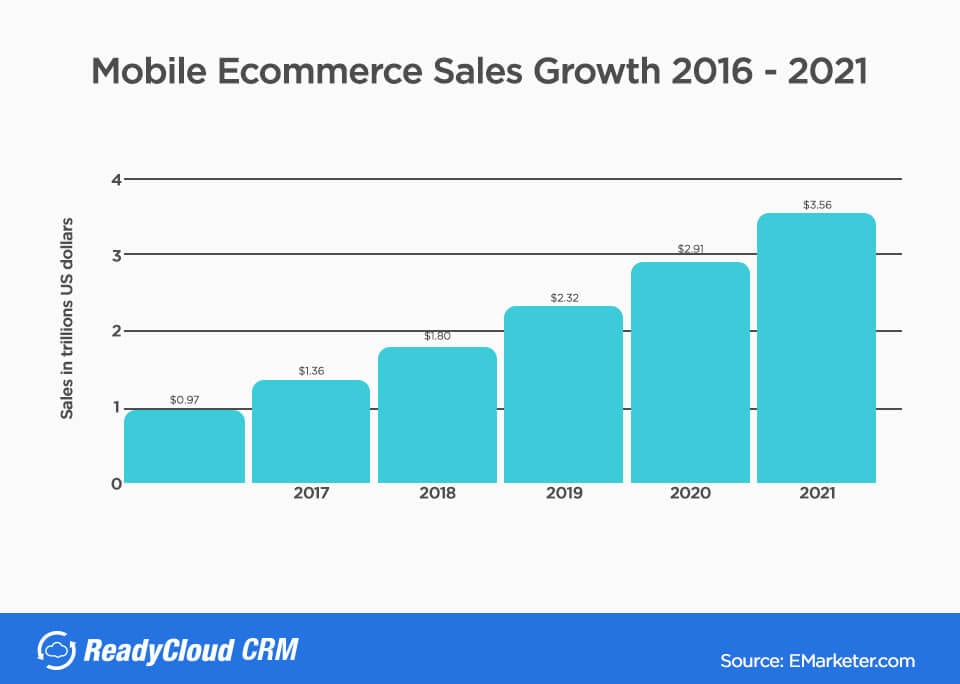
By 2021, mobile commerce sales are expected to top $3.2 trillion for the first time. An estimated 5 billion plus mobile users with convenient access to ecommerce and marketplace websites will spend like they’ve never spent before.
All said and done, mobile commerce has grown from a 52.4% share of ecommerce (back in 2016) to a 67.2% market share as of the present day. This massive growth over the past three years has risen by around 30% and counting, and is telling of what lies ahead in 2020 and beyond.
Webrooming & Showrooming
In a recent report we published, we found that around 80% of internet users conduct research on their mobile device before making a purchase, a process called webrooming when shopping online; or called showrooming when shopping in-store. Across the board, around 70% of internet users agree that webrooming and showrooming are important aspects to making a purchase, regardless of whether that purchase is online or offline.
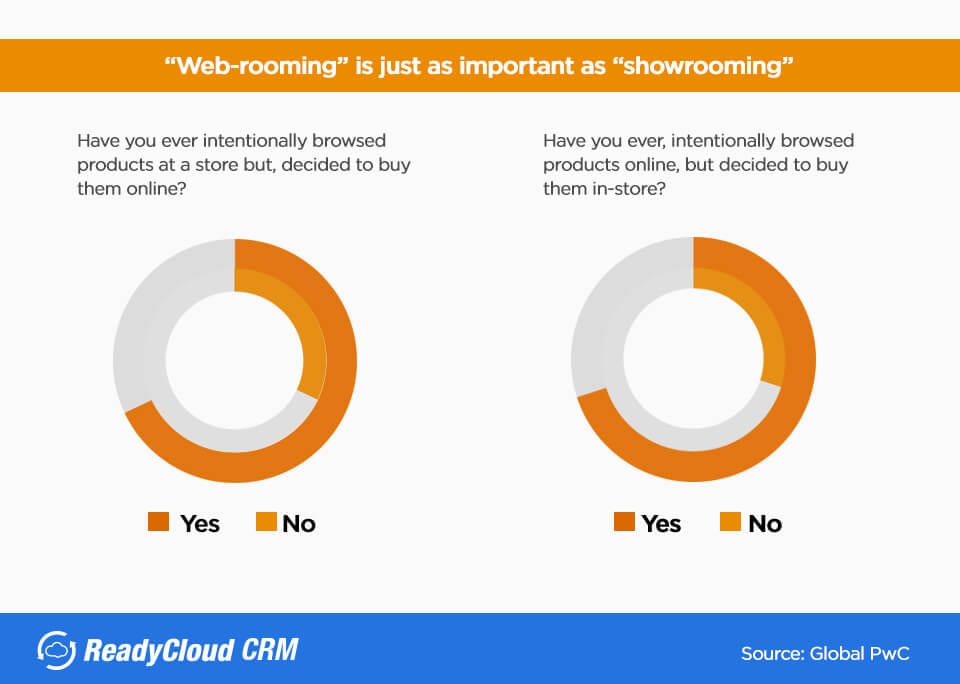
What are these consumers looking for when they webroom and showroom? These statistics on mobile webrooming and showrooming for 2020 help us better understand:
- About 30% of consumers are looking for a price-match policy when webrooming.
- Nearly 45% of shoppers webroom when shopping for holiday gifts.
- 20% of the top online retailers have price-match policies in place to attract webroomers.
- About half of all webroomers are using a mobile device.
- 40% of webroomers just want to find the lowest price.
- 45% of webroomers have found a lower price online after shopping locally.
- 90% of shoppers webroom before they make a buying decision.
- 75% of webroomers are confident it’s the best way to find the lowest price.
- Zappos automates webrooming prices in real-time to give shoppers instant price-matches.
- In 2018, webrooming generated at least $2 billion in online sales.
- 90% of shoppers have webroomed.
- 60% of webroomers have showroomed.
How Amazon Changed the Game
Unsurprisingly, Amazon is the leader in the ecommerce space and currently commands nearly 48% of all online sales. Needless to say, the internet has been forever changed by the entrance and utter domination by Amazon in all regards—from offering just about everything you could ever want online, available for sale with one-day delivery (in many cases) to offering home assembly services, grocery delivery and even online prescription filling services (and so much more).
Amazon has become so large, in fact, that as of 2017, its current annual revenue topped the combined haul of Best Buy, Target, Costco, CVS and Walmart. To think that an online retailer could establish itself as a more revenue-positive than five of the largest brick and mortar retailers combined is simply astounding.
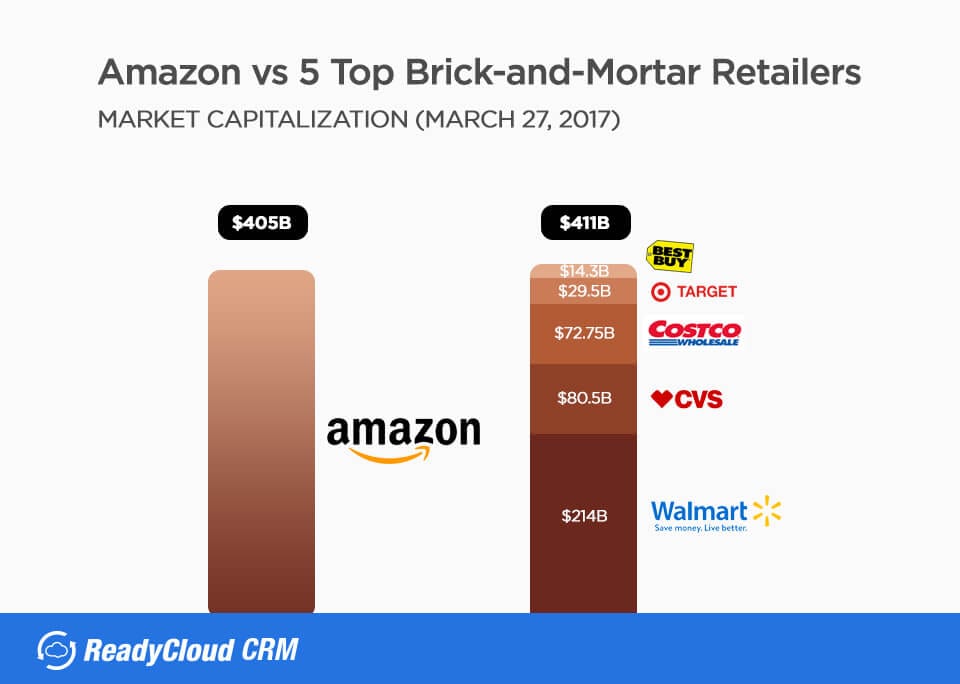
This dominating market share has helped Amazon secure more than 4% of the global retail market, a stat worth bragging about. What’s more, as of 2020, Amazon currently captures about 47% ecommerce sales online, with predictions for 2021 forecasting that it will soon own 50% of the total market. Perhaps the most interesting part of this equation is how mobile commerce factors in: Half of all sales on Amazon come from a mobile device.
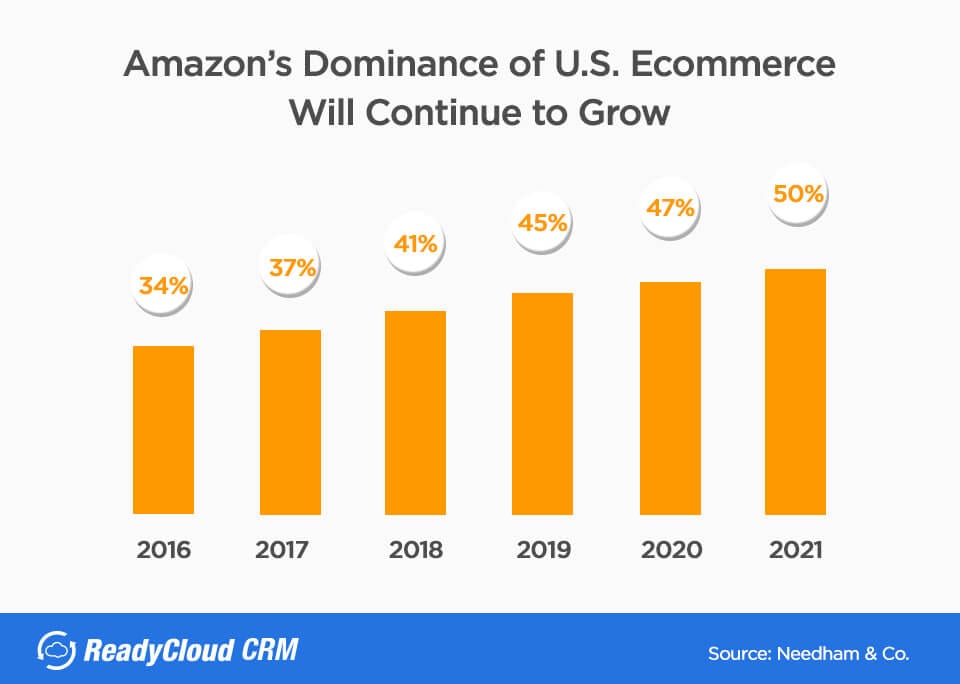
These Amazon statistics show why it’s a major player:
- Prime users spends $625 per year.
- Amazon Prime currently features 20 million products for sale.
- Nearly 80% of customers pay for Amazon Prime to get free shipping
- Around one-third of online shoppers in the U.S. are Prime members.
- Half of Amazon’s online sales come from mobile devices.
- More than 150 million people made a purchase on Amazon from a mobile device last year.
- More than 63 million users accessed Amazon from a mobile device last year.
- Amazon is the most popular site for mobile-only users worldwide.
Black Friday/Cyber Monday Effect
Perhaps the greatest feat accomplished in mobile commerce this past year was the surge in handset and tablet spending that occurred over the Black Friday/Cyber Monday shop-a-thon weekend, where mobile shopping eclipsed $3 billion in Black Friday and Cyber Monday sales for the first time ever, representing a 35% increase in mobile sales year-over-year.
Shoppers also relied on their mobile devices to webroom and showroom when making a buying decision, with 88% of shoppers webrooming and 76% of shoppers showrooming before deciding what to buy.
At the end of this raucous weekend, mobile sales outdid desktop sales at every turn. A look at the chart below is telling. As you can see, mobile is the clear choice of device for shoppers over the holidays. This makes perfect sense, as people can access an online store via their handset from anywhere, as opposed to having to be positioned stationary behind a desktop or a laptop computer.
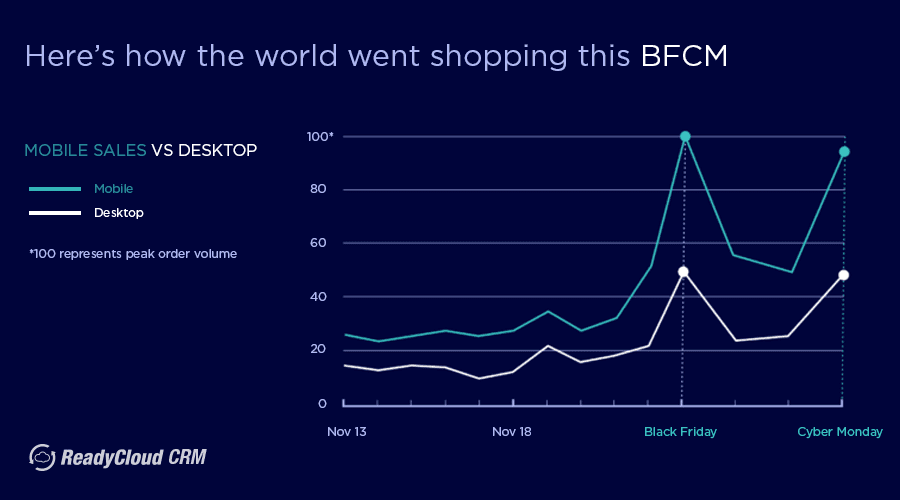
2020 Mobile Commerce Statistics
Here are the most recent mobile commerce statistics for 2020 we’ve been able to dig up for you:
- Nearly 53% of internet usage worldwide is mobile.
- Almost 60% of internet traffic in the US is mobile.
- Ecommerce interactions increase 200% with mobile.
- Around 75% of spending on digital ads will be mobile in 2020.
- About 70% of companies have a mobile advertising strategy.
- More than 40% Black Friday sales this year will be mobile.
- By 2021, mobile payments will increase by at least 35% year-over-year.
- Email helps influence as much as 72% of mobile commerce sales.
- A load time of three seconds or more can increase abandonment rates by 90% on mobile.
- More than 80% of mobile users showroom when shopping locally.
- At least 65% of mobile users webroom when shopping online.
- Mobile commerce sales exceeded $700 million in 2019.
Infographic on Mobile Commerce
Need even more tips? We’ve got you covered with this up-to-date infographic that gives you a complete breakdown of the most recent 2020 mobile commerce statistics.

Share On:








